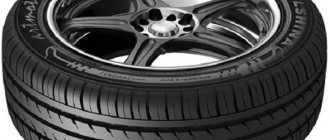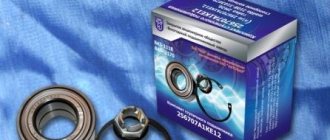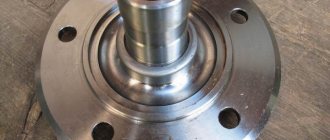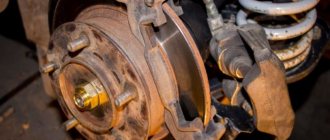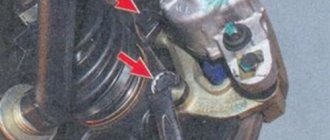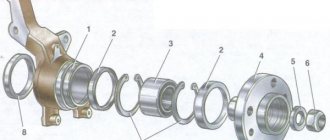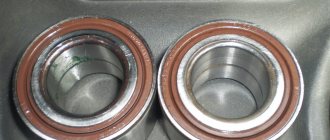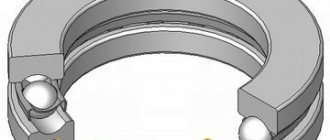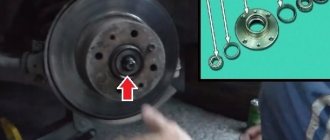Replacing the front wheel hub bearing
Note.
Replace both front wheel hub bearings at the same time. Part numbers can be found here
Figure 5-5 — Steering knuckle with hub assembly: 1 — front wheel hub; 2 — retaining ring; 3 — hub bearing; 4 - steering knuckle
Install the steering knuckle 1, Figure 5-6, on the press table, using technological supports under the surface of the knuckle, install mandrel 2 on hub 4 and press the hub out of the bearing (mandrel marked “1” from the set of mandrels 67.7853-9727).
If you do not have a press to replace the bearing, you can use a commercially available puller to press out and press in the wheel bearings.
Figure 5-6 - Pressing out the front wheel hub from the steering knuckle: 1 - steering knuckle; 2 — mandrel 67.7853-9727-1; 3 — retaining ring; 4 — hub; 5 - bearing; P - direction of pressing out the hub
Figure 5-7 — Pressing the inner ring of the front wheel hub bearing: 1 — hub; 2 — inner ring of the bearing; 3 — stop 67.7853-9727-4; 4 - double-lever or three-lever puller
Remove the hub. Most likely, the outer half of the inner race of the bearing will remain on it.
To remove the outer half of the bearing inner race from the hub, first remove the bearing seal shield.
Place hub 1, Fig. 5-7, in a vice, install stop 3 on the hub and compress it with puller 4.
. the outer half of the 2nd inner ring of the bearing remaining on the hub
If a puller is not available, the outer half of the inner bearing race can be removed from the hub by carefully striking a thin chisel inserted between the edge of the ring and the hub shoulder.
Remove retaining rings 3, Figure 5-6 (removal of internal retaining rings).
Install the steering knuckle 3, Figure 5-8, on the press table at stop 4, install mandrel 1 on bearing 2 and press the bearing out of the steering knuckle (mandrels marked “2” and “5” from kit 67.7853-9727).
Figure 5-8 — Pressing out the front wheel hub bearing from the steering knuckle: 1 — mandrel 67.7853-9727-2; 2 - bearing; 3 — steering fist; 4 — stop 67.7853-9727-5
Clean, rinse and blow out the steering knuckle and hub with compressed air. Clean the grooves for the retaining rings.
Figure 5-9 — Pressing the front wheel hub bearing into the steering knuckle: 1 — mandrel 67.7853-9727-2; 2 - bearing; 3 — retaining ring; 4 — steering fist; 5 — stop 67.7853-9727-5
ATTENTION If you do not support the inner race of the bearing when pressing the hub, it can be damaged.
Install the outer retaining ring 3, Figure 5-9, into the groove of the steering knuckle 4 and press the new bearing 2 until it stops into the retaining ring. Apply the pressing force to the outer ring of the bearing (mandrels marked “2” and “5” from kit 67.7853-9727).
Secure the bearing in the steering knuckle with the second circlip (internal circlip puller).
Press steering knuckle 1, Figure 5-10, with the bearing assembly onto hub 3 until it stops. Apply the pressing force to the inner ring of the bearing through mandrel 5 (mandrels marked “3” and “6” from kit 67.7853-9727).
Figure 5-10 — Pressing in the front wheel hub: 1 — steering knuckle; 2 — retaining ring; 3 - hub; 4 — stop 67.7853-9727-6; 5 — mandrel 67.7853-9727-3; 6 - bearing
Insert the front wheel drive shaft into the hub splines, insert the steering knuckle ear into the front suspension strut bracket, insert two bolts 6, Figure 3-2, fasteners and tighten nuts 4.
The tightening torque of the nuts is 90. 120 N.m (9.0. 12.0 kgf.m) (ring wrench “18”, head “18”).
Figure 3-2
Insert the ball joint pin of the lever 3, Figure 4-3, of the front suspension into the steering knuckle and tighten the fastening nut 4, if necessary, holding the ball joint pin from turning.
The tightening torque of the nut is 53. 71 N.m (5.3. 7.1 kgf.m) (Torx angle wrench T40, ring wrench “18”, ring attachment 18).
Figure 4-3
Insert the ball pin of the tie rod end 5, Figure 5-4, into the steering knuckle lever 3 and tighten the fastening nut 4, if necessary, holding the ball pin from turning. The nut tightening torque is 32. 42 N.m (3.2. 4.2 kgf. m).
Figure 5-4
Install speed sensor 1 into the mounting hole of the steering knuckle and tighten bolt 2.
The bolt tightening torque is 6.7 N.m (0.6.0.7 kgf.m).
Attention. Before installing the speed sensor, apply lubricant (Litol-24, or LSTs-15, consumption 1 g) to the surface of the mating hole.
Install the speed sensor wiring harness into the mounting bracket on the front suspension strut.
Install the protective casing 2, Figure 5-3, onto the steering knuckle and tighten the three fastening bolts 1.
The tightening torque of the bolts is 7. 9 N.m (0.7. 0.9 kgf.m).
Figure 5-3
Install disc 1, Figure 5-2, of the front brake on the wheel hub and tighten two bolts 2 fastening.
The tightening torque of the bolts is 17. 23 N.m (1.7. 2.3 kgf.m).
Figure 5-2
Attention. The front brake mounting bolts must be replaced; bolts may not be reused.
Install the front brake on the steering knuckle and tighten two new mounting bolts.
The tightening torque of the bolts is 90. 120 N.m (9.0. 12.0 kgf.m).
Standard hub - article number and price
The diameter (size) of the Lada Vesta car hub is 129 mm; this small part is susceptible to dirt, which increases the friction force and reduces its efficiency. The bearing size is 10 cm in diameter, 1 cm in thickness. To protect this small part from dirt, West owners buy plugs (article number 8450008616, and for SW and SW Cross - 2194310101400), which cost from 100 to 200 rubles.
Front
The front hub received catalog number 8450006806, it costs from 500 rubles. The bearing for it has the number 7700432405, sold at a price of 700 rubles. and higher. Hiding behind the wheel next to her:
- steering knuckle (left – 8450006790, price 6700 rubles; right – 8450006789, price – 5000 rubles);
- brake disc (article 8450006845, price - 950 rubles);
- retaining ring (article 6040001505, – from 60 rub.);
- bolt with a countersunk head (article 7703004176, price - from 70 rubles);
- screw with a semicircular head (article 7703008257, – from 80 rub.).
Rear
The rear hub of the Lada Vesta works in strict symbiosis with drum brakes. The design looks like this:
- a bolt secures the rear hub axle to the drum (bolt part number - 2194310101400);
- the axis of the rear part (430423019R, cost 400 rubles) is connected to the drum through a magnetic ring;
- magnetic ring (4797703074R, price 400 rubles);
- finally, a drum assembled with a bearing with abs (432008333R, price 400 rubles);
- on the other side of the drum - a bearing and the main part assembly (8200600646, costing 400 rubles);
- followed by a retaining ring (7703066036, from 200 rubles);
- A self-locking nut is “put on” the thread, on which a nylon insert is installed (7703034250, price - 100 rubles).
The entire structure can be completed with a cap - again, to prevent dirt from getting in.
Life hack: Vesta car front and rear wheel bearings - replacement instructions
In order for the wheel to rotate and stay firmly in place, in addition to the ball joint, the suspension mechanisms include a hub bearing. On Lada Vesta cars there are front and rear bearings, since in some Vestas there are drums at the back, not calipers. Replacing a part on a hundred will cost from 1000 to 2000 rubles. The wheel bearing tends to howl, the first Vesta cars were famous for this disease. As always, the first models come out like raw meat, often inheriting the diseases of previous models. Lada Vesta did not break this tradition. AvtoVAZ even gave an explanatory letter admitting that the front right/left wheel was howling and advised changing the assembly. Below in the article you will find the official letter. The price for the front wheel bearing of a Vesta car starts from 1000 rubles. The part is available for cars with and without abs. True, I have never seen Vesta without abs.
Short recommendations
When choosing a new part to replace the front wheel bearing for a Renault Logan car, carefully study the condition of the packaging and the presence of preservation lubricant. It is important that the part does not jam when rotating. There should be no traces of corrosion on the body; the same recommendations apply when changing the Logan support ball bearing. It is better to purchase spare parts in certified stores, and a price below 1,500 rubles should be alarming.
During repairs, it is worth checking the condition of all elements of the front suspension. Socket heads can be used as mandrels. If you have doubts about your abilities, then it is better to entrust the stage of pressing the ball bearing to the masters. After the repair, the wheel alignment needs to be adjusted at a service center.
A study of Internet forums dedicated to the operation of AVTOVAZ products showed that the happy owners of LADA Granta have accumulated a lot of technical complaints. First of all, we are talking about the reliability and quality of machine components and assemblies. We decided not to be too clever, but simply to give only the most typical quotes from real owners of LADA Granta.
— 38,000 km and 2.5 years of ownership: replaced daytime running lights, the window lift button was malfunctioning — I removed and cleaned the contacts. At 33,500 km, the support bearings of the front struts clicked. In winter, at 30,000 km, the fuel hose dripped in the quick-release coupling.
The sensor is installed on the throttle assembly and connected to the throttle valve axis.
You will need a screwdriver.
Replacing the Throttle Position Sensor 1. Disconnect the wiring harness connector from the sensor.
Read more…
Basic faults
As a result of regular use of the car, over time, most parts wear out and may break. One of the most vulnerable parts of a vehicle is the suspension, which smooths out road unevenness and takes the blows.
The bearing design consists of two metal rings. Inside there are balls of insulating material. The entire structure is covered with plastic casings. Internal graphite-based lubricant protects materials from abrasion while the internal race of the part rotates along with the hub.
For no apparent reason, car parts usually do not break. The process occurs unnoticed, but allows the driver to have time to react to a breakdown if he pays attention to the characteristic signs in time.
The purpose of bearings is to ensure the rotation of the wheels and also to hold the hubs firmly. Let's look at their main malfunctions and possible causes:
- Front wheel play.
- Vibrations of different degrees of intensity.
- A pronounced hum and other extraneous sounds when the wheel rotates, similar to the grinding of metal, crunching, knocking.
- Vibration in the steering wheel that increases with speed.
- The car skids to the side.
- Off-road driving, extreme driving, with sharp braking, acceleration (drifting), can damage any, even reliable, part of the car.
- The cause of component failure may be vehicle overload.
- As a result of sand, moisture, or dirt getting into the rotating parts of the bearing, the lubricant may evaporate and the inner or outer rim may crack. During long-term operation, the protective elements of the part become unusable, the tightness of the structure is compromised, and dirt can penetrate into the working area, washing out the lubricant.
- The rollers themselves are rarely destroyed. The reason may be inadequate factory quality.
- If the mechanism is replaced incorrectly, another replacement will be required.
The technician will advise you, after detecting a malfunction, to go to the nearest workshop, not exceeding a speed of 40 km/h.
Structurally, the front and rear hubs of the Lada Vesta car consist of:
- metal frame: external, internal;
- a bearing with metal balls (rollers) located in it;
- insulating rings;
- special filler - graphite-based lubricant.
Before starting to disassemble the mechanism, it is necessary to diagnose the hub mechanism. To this end:
- Place the vehicle on a level platform with the parking brake released to check the front row.
- Install wheel chocks to check the rear row: jack up the front (or rear) part.
- We turn the car wheel and carry out troubleshooting.
- Use your hands to loosen the wheel up and down; there should be no play. If there is one, we dismantle it, replacing worn parts and components.
Ball joint knock
After 60 - 65 thousand kilometers, owners note the appearance of a knocking sound in the area of the axle shaft. Most often when turning at low speed.
The tip of the ball joint is rolled into a plastic sleeve. During the systematic operation of the car, the moving surfaces wear out and play forms.
The process of replacing the ball joint yourself is not difficult, but be careful not to violate the installation technology.
To verify that the ball is faulty, just jack up the side of the car. Loosen the wheel up and down, the presence of knocks and clicks will be a sign of wear on the ball joint.
Replacing the front wheel bearing Lada Vesta - removal and installation
- Place the steering knuckle in a stationary vice and knock out the central part of the part.
- To dismantle the inner part of the cage, use a chisel, applying targeted blows with a hammer. Leave the outer part of the inner ring.
- Remove the mud ring from the hub.
- Using a chisel, move the inner race of the bearing.
- Use a puller to compress the part.
- Use pliers to remove the retaining ring.
- Remove the bearing. To do this, disconnect the inner race of the hinge; it is convenient to use round teeth.
- Remove the part along with the puller.
- Clean the surface from accumulated dirt, rust, and grease. Lubricate the inner surface of the steering knuckle.
- Clean out dents from the chisel, if any have formed.
- Apply a thin layer of graphite grease to the surface. Press in the new mechanism; the retaining ring should fit with the edge of the part.
- Press the new mechanism into the steering knuckle, applying force to the outer ring.
- Install a locking device on the groove of the steering knuckle socket.
- Attach the steering knuckle to the shock strut bracket, align, and tighten the nuts of the steering knuckle bolts.
- Insert the splined part of the outer drive joint into the wheel hub. Put on the washer and tighten the new fastening nut without tightening it.
- Attach the ball pin of the suspension arm to the steering knuckle and tighten the two bolts.
- Install the front brake guard and disc.
- Secure the front brake to the steering knuckle with two bolts.
Content:
- 1 Installation principle/drilling
- 2 Which disks to choose
- 3 Parameters of factory-installed tires and their characteristics
- 4 So, what about the sizes in the end?
- 5 Effect of tire and wheel size
- 6 Acceptable dimensions
- 7 What do additional parameters mean?
Even when the car was under development, there were rumors that the wheel size would be R15 inches. But it turned out that these were just rumors, and the car rolled to the “people” on tires with a radius of R16 and R17. To say that this surprised many would be an understatement. There were also those people who at first tried to change the car to wheels with a smaller diameter, but their efforts were in vain thanks to the efforts of the car plant designers.
Replacing front wheel bearings
Standard replacement of the Lada Vesta wheel bearing is carried out in a workshop or equipped garage. To perform the operation you will need the following tools:
- set of wrenches;
- wheel removal tool;
- jack and goat stands;
- special bearing puller;
- chisel;
- circlip remover;
- screwdriver;
- hammer;
- pliers with round jaws.
A metal brush, rags, and WD40-type liquid may also be useful for cleaning dirt.
Sequencing
The procedure for removing the hub support bearing is as follows.
- Drive the car into the garage and loosen the bolts holding the wheel. It is important to just loosen the bolts - you do not need to unscrew them completely. Next you will need to remove the terminals from the battery.
- Raise the car with a jack and place it on trestles. If possible, it is recommended to use a lift. This will make the operation more comfortable.
- Remove the wheel from the car. Next, using a soft brush, you should clean all surfaces from dirt, plaque and dust. The further procedure must be carried out with utmost cleanliness. It would also be a good idea to place cardboard or a rag under the work area.
- Next, you need to open the cap of the hub nut and use a 30 socket to unscrew it. In this case, you should use a lever - the device is clamped tightly enough and secured, which prevents it from unintentionally unscrewing.
- When you have access to the caliper, you need to use a flat-head screwdriver to move the piston and spread the pads. During the procedure, you need to monitor the level of brake fluid in the Republic of Belarus. If the liquid overflows, it is convenient to remove the excess with a syringe.
- The next step is dismantling the caliper. Using wrench No. 18, unscrew the two mounting screws and hang the brake on a spring or other element. In this case, you will need to be careful and remove the brake line away from sharp objects.
Next, the brake disc is unscrewed. To do this, take a TORX head of the appropriate size and unscrew the two fastening screws. The disc itself must be carefully placed on a clean surface. During removal, it is recommended to touch the working surface of the rotor less - this part is sensitive to grease. Next, using the same torx, you will need to unscrew the protective covers and speed sensor. For convenience, the sensor can also be attached to a spring.
- Next, you should rip off the tie rod mounting nut and, using a squeezer, remove it from the steering knuckle. For convenience, you can hold the ball part from turning with a hexagon.
- After preparation, you need to dismantle the suspension arms and wheel drive. Here the mounting bolts and nuts are unscrewed in order. The master’s task is to completely free the steering knuckle and hub from the suspension elements.
- After all the manipulations, you can begin to replace the bearing itself. The fist is clamped in a yew or fixed in another convenient way.
- Next, using a special puller, you need to remove the retaining rings from the seats. In this case, you need to act carefully - the rings are made of special steel and can bounce off. Then, using a tool, you need to knock out the hub along with the bearing from the steering knuckle. The main rule here is accuracy. You need to hit the guide carefully so as not to damage the part.
- Now the hub is completely freed from the knuckle and the bearing can be pulled off.
- Subsequent steps require a special squeeze. If there is no such thing available, you should not even start the procedure. The principle of operation is shown in the photo.
- Next, replacing the support bearing of the Lada Vesta proceeds to the vehicle assembly stage.
- Using a stream of compressed air, you need to clean the seats and completely remove all dirt from the parts.
- Install the outer retaining ring onto the steering knuckle and press the new bearing all the way into its seat. Insert the second ring into the retaining groove.
- The final stage is pressing the hub into the inner part of the bearing.
- Subsequent assembly of the mechanism is carried out in reverse order. The most important factor is maintaining utmost cleanliness and precision. Even a small amount of dirt that gets into the inside during installation significantly shortens the life of the parts.
Installation
In order to cover the steering wheel of an X Ray or Vesta with leather braiding, no special knowledge or experience is required. The main thing is diligence and patience, since, despite the fact that the braid is pre-stitched and you only need to sheathe the steering wheel with it, you will have to set aside several hours for this.
Naturally, it is much more convenient to work when the steering wheel is removed, although some prefer to stretch the braid over the Vesta steering wheel right in the car. However, both experts and owners still recommend dismantling the steering wheel.
Removal
Removing the steering wheel of a Lada Vesta or X-Ray is not too difficult, especially considering that everything is done according to the same algorithm. First you need to remove the terminal from the battery. In addition, you should wait a little (at least a couple of minutes) for the activator capacitor to discharge.
List of required tools:
— 2 thin rods or screwdrivers;
- ratchet;
— Torx 50 bit;
- extension cord;
— 2-lever puller.
First you need to remove the airbag to gain access to the steering wheel mount itself. To do this, you need to arm yourself with a pair of thin rods or nails, about 5 mm in diameter.
There are recesses on the sides of the steering wheel, where you need to insert both rods, and then press on them at the same time. This will tighten the spring clips, and the pillow itself will rise slightly. Here you will need help, since the airbag module will need to be removed and the plugs disconnected.
When the module is removed, you will have access to the bolt (marked 3) that secures the steering wheel. To unscrew it, you will need a ratchet, an extension and a Torx 50 bit. The car wheels must be placed straight, and then unscrew the bolt in the center of the hub. Next, you need to pull the steering wheel towards you and remove it, while simultaneously pushing the connectors for the airbag and horn wires into the hole in the center. In addition, if your car is equipped with a multi-steering wheel, you will need to disconnect the corresponding block.
Next, all that remains is to remove the fuse (transportation) from the steering pocket, marked with the number 5, and then insert it into the rotating mechanism.
This completes the procedure for removing the Lada Vesta steering wheel. All that remains is to first remove the plastic insert from it. This is not easy to do, since it is held on by 8 clips that are inserted into the rubber base.
The removal process is clearly shown in the video.
Padding
Self-upholstery of the steering wheel of a Lada Vesta and X-Ray into leather is quite possible. Everything is described in detail in the re-upholstery instructions. However, many note that it is better to turn to a professional. The most difficult thing about reupholstering a Lada X-Ray steering wheel yourself with leather is the stitches and the formation of grooves “to match the factory ones.”
However, you can choose different stitch options whichever you like best. The main thing is to do everything measuredly and exactly according to the instructions. Then the result will definitely please you.
The process is clearly demonstrated in the video. In it, the master, using the example of a Toyota, shows the entire process of re-upholstering the steering wheel, including dismantling, making patterns, preparing the braid and steering wheel, as well as installation
Since the steering wheel braid for the Lada Vesta and X-Ray is already ready, you need to pay special attention to the re-upholstery process, which begins at 14:45
Installation
Installing the Vesta steering wheel is carried out in the reverse order, but there are several nuances.
The steering wheel fastening bolt removed during dismantling cannot be used. You need to buy a new bolt, and its tightening torque must be in the range of 38-50 Nm, which is equivalent to 3.8-5.0 kg/s.
In the case where there is no transport safety lock, it is necessary to inspect the position in which the contact disk of the (rotating) steering column switch unit is located. If it is not level, it needs to be placed in the middle position
It is important to align the splines on the shaft and hub of the steering wheel, and also to align the ebbs on the steering wheel with the grooves.
Sources
- https://avtozapchasti-vaz-saratov.ru/kak-snyat-rul-lada-vesta-ili-lada-xray.html
- https://vesta-lada.com/kak-legko-i-prosto-snyat-rul-s-lada-xray-i-lada-vesta/
- https://club-vesta.ru/oborudovanie/samostoyatelnaya-peretyazhka-rulya-lada-vesta-i-iks-rej-kozhej
How to replace the rear bearing on Vesta
The standard replacement of the Lada Vesta rear wheel bearing is carried out independently only after measuring the axial clearance and checking the condition of the part. If the troubleshooting results are not satisfactory, the bearing needs to be replaced. The operation will require similar instruments. And the procedure itself looks like this.
- The preparatory work is similar to the procedure for replacing the front wheel.
- The disc is removed from the car and the brake drum is exposed.
- Using wrench No. 17, the hub cap is removed and the brake drum is dismantled.
When using a magnetic puller, the magnetic ring is squeezed out. The part helps hold the structure in place. After disassembling the mechanism, the TB should be installed on a flat surface and an extension should be installed in the inner part of the bearing to press it out. For the best effect, you will need a press; if you don’t have one, you can use a hammer.
Generator repair
The following describes the repair procedure for sliding inserts and power generation devices. Replacing the Lada Vesta generator bearing will require the tools indicated at the beginning of the article. The repair procedure itself looks completely different.
- Place the machine on a level surface and securely fix it.
- Disconnect battery power.
- Loosen the tension roller of the crankshaft belt and accessories.
- Using a Phillips screwdriver, unscrew the power conductors of the generator device and remove them from the repair area.
- The generator is removed using a 13 mm wrench and a screwdriver. To do this, you need to find and unscrew the two bolts on the bracket securing the device to the engine block.
- Next, you can carefully remove the device itself from the machine for subsequent repairs.
- After dismantling, use a screwdriver to unscrew the two screws of the cover and remove the latter.
- Under the cladding there is a diode bridge and a regulator. The parts are fixed on a special panel, which is pulled off the shaft along with the bearing.

